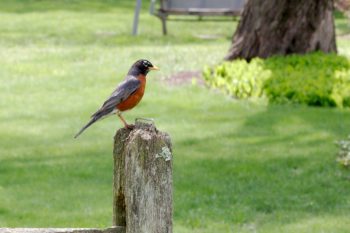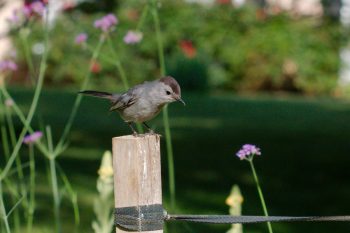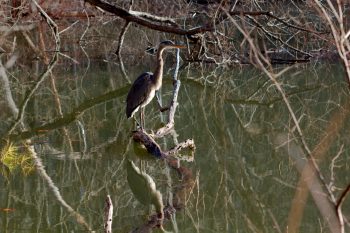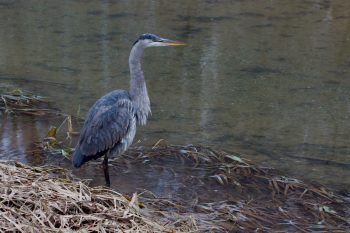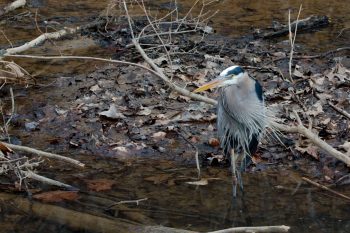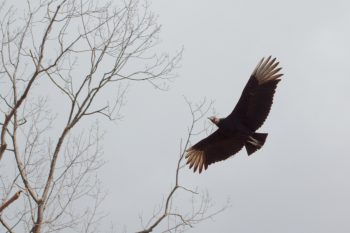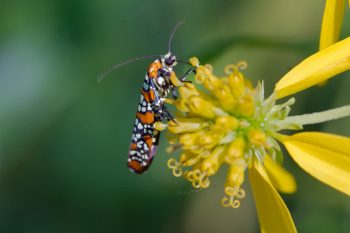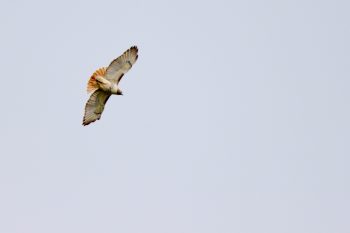One of the most common birds in our area, winter or summer, is the American robin (Turdus migratorius). They are always around, in the lawn, in trees, singing and making a racket throughout the day. They aren’t anywhere near as cute as the European robin (Erithacus rubecula), which is classified as an Old World flycatcher (family Muscicapidae) rather than a thrush (family Turdidae), which is where the American robin stands. Although they are migratory (as their specific epithet suggests), their winter and summer ranges overlap and they can be seen year round through nearly all of the contiguous 48 states.
Tagged With: Bird
American Robin (Turdus migratorius)
Gray Catbird (Dumetella carolinensis)
After work, except on days when it’s raining, I’ve been trying to sit in the yard to read. It’s started to get warm lately but I’ve still gone out, sitting in the shade after 5:00 PM, when it’s not quite so bad. I take my camera with me and look around for something to photograph. While I was reading, this gray catbird (Dumetella carolinensis) came and sat on the stake holding up our new hawthorn tree. It looked around for a little while and then flew off. There are quite a few of them around and since they are insect eaters, I’m quite happy to have them.
Great Blue Heron (Ardea herodias)
We went to the Tridelphia Reservoir this afternoon to two different parking areas and walked out and back along trails from both. The first wasn’t as nice as we had hoped, although we saw two types of clubmoss, Diphasiastrum digitatum (fan clubmoss) and Dendrolycopodium obscurum (ground pine). The walk from the second parking area was really nice. It was an easy walk except for a few places where there was mud on the trail but it wasn’t hard to get around. We were about to turn around when Cathy spotted this great blue heron (Ardea herodias), who let us get quite close. We just stood and watched it for quite a while.
Great Blue Heron (Ardea herodias)
We went for a walk on the C&O Canal this afternoon, heading northwest from Pennyfield Lock. We saw a few great blue herons Great (Ardea herodias), including this one who posed for us very nicely. It was a lovely day and really good to be outdoors. The canal is nice, especially a little ways out from Great Falls Tavern, because it’s open and there aren’t a lot of people. More people than on some trails but not so many it’s a pain, trying to keep our distance from everyone.
Great Blue Heron (Ardea herodias)
We walked on the C&O Canal again this afternoon, returning to Pennyfield Lock but walking southeast instead of northwest. We saw three herons including one in a tree over the canal and this one, wading in the water. It seems like a good time of year for them and it’s particularly nice to see them as close as this. The trees are all bare, of course, which makes things in the trees easier to see. It was cool out today but not cols, so a really nice day for a walk.
Black Vulture (Coragyps atratus)
We met some friends at Violet’s Lock on the C&O Canal and went for a walk with them, heading southeast on the towpath. It was a cool day, mostly overcast, but it was really good to be outdoors. We didn’t seem herons as we have recently but did get a pretty good view of this black vulture (Coragyps atratus) flying overhead. This outing was mostly to visit with our friends, and I only took a few photos but I’m pretty happy with this one. Vultures are not most peoples’ favorite bird but they have a beauty of their own.
Moth and Eagle
We had some out of town guest this weekend but they were here mostly to do the D.C. tourist thing. Late this morning the headed downtown to hit the museums and Cathy and I decided to go to the C&O Canal, walking northwest from Pennyfield Lock. It was a beautiful day, warmer than I prefer but only by a little. In the shade and particularly when there was a breeze it was lovely. We saw lots of painted turtles (Chrysemys picta), a great blue heron (Ardea herodias) and quite a few wildflowers. For today’s post I’m putting up two photos. The first is an ailanthus webworm moth (Atteva aurea) on a sunflower (Helianthus) of some sort. The larvae live in communal webs on their host trees. Interestingly, while they are thought to be native to South Florida, the ailanthus for which they are named (Ailanthus altissima, Tree of Heaven), is native to Northern China. It is believed that their original larval host was the paradise tree (Simarouba glauca) and Simarouba amara. It started moving north around the 1850s when introduced Ailanthus altissima contacted the moth’s native range.
The second photo is, as you have probably surmised, a Bald Eagle (Haliaeetus leucocephalus). Cathy had walked a little further along and I waited in the shade at a pretty spot to take a few photos of the wildflowers there. While I was waiting for her to return I looked up and saw the eagle. I was able to point him out to a few others walking or biking on the canal but it was gone before Cathy returned. This isn’t the sharpest photo but it’s pretty clear what it is. The dark spot in the lower right is another bird. There were quite a few, flying fairly high in the sky.
Red-tailed Hawk (Buteo jamaicensis)
We went to the farm park for a short visit today. I got a few photos of bluebirds, both male and female (Sialia sialis), a red-winged blackbird (Agelaius phoeniceus), and a sparrow or other small bird that I can’t identify. I decided to go with this shot of a red-tailed hawk (Buteo jamaicensis), though. Taking photos of birds on the wing is challenging at the best of times. With my long—150–600mm—lens, it’s even more challenging. The lens is quite heavy and getting it aimed at the bird, much less focused is pretty hit or miss. Mostly miss. This one turned out pretty well and I got a few more just about the same, so I’m please with that.

